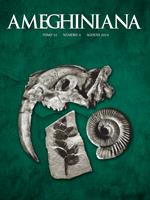The purple clam Amiantis purpurata (Lamarck) is a warm-temperate species inhabiting shallow water along the coast from Espiritu Santo (Brazil) to northern Patagonia. It is one of the few survivors of the middle—late Miocene faunal turnover which was characterized by the appearance of new taxa, most of them living now along the Argentinean coast. In order to study the biogeographic history of A. purpurata, a detailed review of its records was carried out. The oldest record of this species is from late Miocene rocks in Uruguay, and it appears that A. purpurata survived because its wide thermal tolerance range allowed larvae to migrate southwards from Uruguay, settling on the southern coast of Buenos Aires Province and San Matías Gulf. The characteristics of this gulf would have favored the development and settlement of the larvae, thus giving rise to the most abundant southern population during the Pleistocene. At the end of the Pleistocene, A. purpurata also survived the Last Glacial Maximum. During the Holocene, the population of A. purpurata in San Matías Gulf became isolated, but also represented the most abundant southern population of this species. During its brief Neogene history, Amiantis purpurata followed main global, regional and local events; thus it can be considered as an environmental indicator for this period.
How to translate text using browser tools
1 August 2014
The Relictual Population of the Purple Clam Amiantis purpurata (L.) in Northern Patagonia (Argentina): The History of a Warm-Temperate-Water Neogene Survivor
M. Sol Bayer,
Sandra Gordillo,
Enrique Morsan
ACCESS THE FULL ARTICLE

Ameghiniana
Vol. 51 • No. 4
August 2014
Vol. 51 • No. 4
August 2014
Amiantis purpurata
dispersion
Dispersión
Neogene
Neógeno
Paleobiogeografía
Paleobiogeography




